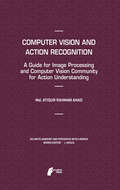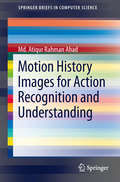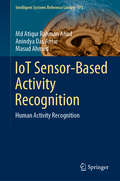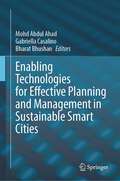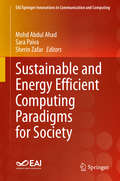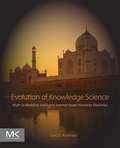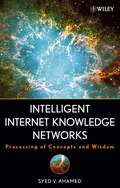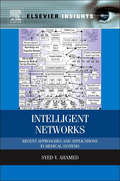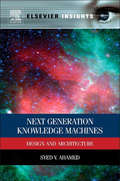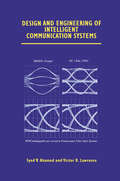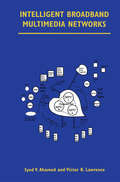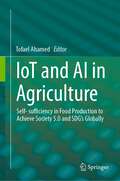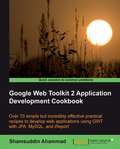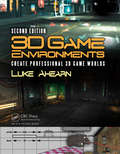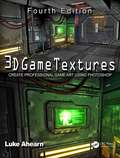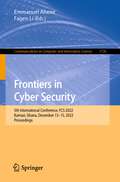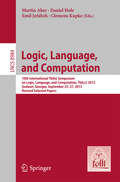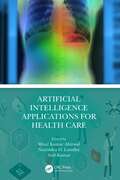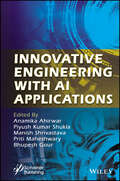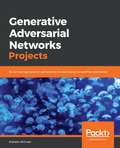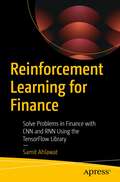- Table View
- List View
Computer Vision and Action Recognition: A Guide for Image Processing and Computer Vision Community for Action Understanding (Atlantis Ambient and Pervasive Intelligence #5)
by Md. Atiqur AhadHuman action analyses and recognition are challenging problems due to large variations in human motion and appearance, camera viewpoint and environment settings. The field of action and activity representation and recognition is relatively old, yet not well-understood by the students and research community. Some important but common motion recognition problems are even now unsolved properly by the computer vision community. However, in the last decade, a number of good approaches are proposed and evaluated subsequently by many researchers. Among those methods, some methods get significant attention from many researchers in the computer vision field due to their better robustness and performance. This book will cover gap of information and materials on comprehensive outlook – through various strategies from the scratch to the state-of-the-art on computer vision regarding action recognition approaches. This book will target the students and researchers who have knowledge on image processing at a basic level and would like to explore more on this area and do research. The step by step methodologies will encourage one to move forward for a comprehensive knowledge on computer vision for recognizing various human actions.
Motion History Images for Action Recognition and Understanding (SpringerBriefs in Computer Science)
by Md. Atiqur AhadHuman action analysis and recognition is a relatively mature field, yet one which is often not well understood by students and researchers. The large number of possible variations in human motion and appearance, camera viewpoint, and environment, present considerable challenges. Some important and common problems remain unsolved by the computer vision community. However, many valuable approaches have been proposed over the past decade, including the motion history image (MHI) method. This method has received significant attention, as it offers greater robustness and performance than other techniques. This work presents a comprehensive review of these state-of-the-art approaches and their applications, with a particular focus on the MHI method and its variants.
IoT Sensor-Based Activity Recognition: Human Activity Recognition (Intelligent Systems Reference Library #173)
by Md Atiqur Ahad Anindya Das Antar Masud AhmedThis book offer clear descriptions of the basic structure for the recognition and classification of human activities using different types of sensor module and smart devices in e.g. healthcare, education, monitoring the elderly, daily human behavior, and fitness monitoring. In addition, the complexities, challenges, and design issues involved in data collection, processing, and other fundamental stages along with datasets, methods, etc., are discussed in detail. The book offers a valuable resource for readers in the fields of pattern recognition, human–computer interaction, and the Internet of Things.
Enabling Technologies for Effective Planning and Management in Sustainable Smart Cities
by Mohd Abdul Ahad Gabriella Casalino Bharat BhushanWith the rapid penetration of technology in varied application domains, the existing cities are getting connected more seamlessly. Cities becomes smart by inducing ICT in the classical city infrastructure for its management. According to McKenzie Report, about 68% of the world population will migrate towards urban settlements in near future. This migration is largely because of the improved Quality of Life (QoL) and livelihood in urban settlements. In the light of urbanization, climate change, democratic flaws, and rising urban welfare expenditures, smart cities have emerged as an important approach for society’s future development. Smart cities have achieved enhanced QoL by giving smart information to people regarding healthcare, transportation, smart parking, smart traffic structure, smart home, smart agronomy, community security etc. Typically, in smart cities data is sensed by the sensor devices and provided to end users for further use. The sensitive data is transferred with the help of internet creating higher chances for the adversaries to breach the data. Considering the privacy and security as the area of prime focus, this book covers the most prominent security vulnerabilities associated with varied application areas like healthcare, manufacturing, transportation, education and agriculture etc. Furthermore, the massive amount of data being generated through ubiquitous sensors placed across the smart cities needs to be handled in an effective, efficient, secured and privacy preserved manner. Since a typical smart city ecosystem is data driven, it is imperative to manage this data in an optimal manner. Enabling technologies like Internet of Things (IoT), Natural Language Processing (NLP), Blockchain Technology, Deep Learning, Machine Learning, Computer vision, Big Data Analytics, Next Generation Networks and Software Defined Networks (SDN) provide exemplary benefits if they are integrated in the classical city ecosystem in an effective manner. The application of Artificial Intelligence (AI) is expanding across many domains in the smart city, such as infrastructure, transportation, environmental protection, power and energy, privacy and security, governance, data management, healthcare, and more. AI has the potential to improve human health, prosperity, and happiness by reducing our reliance on manual labor and accelerating our progress in the sciences and technologies. NLP is an extensive domain of AI and is used in collaboration with machine learning and deep learning algorithms for clinical informatics and data processing. In modern smart cities, blockchain provides a complete framework that controls the city operations and ensures that they are managed as effectively as possible. Besides having an impact on our daily lives, it also facilitates many areas of city management.
Sustainable and Energy Efficient Computing Paradigms for Society (EAI/Springer Innovations in Communication and Computing)
by Mohd Abdul Ahad Sara Paiva Sherin ZafarThis book provides insights into recent trends and innovation of technologies aiming to provide sustainable and energy efficient computing. The authors discuss approaches to provide solutions to real life societal issues and problems using sustainable and energy efficient computing approaches. The book gathers research and state of the art reviews on solutions for societal benefits by using sustainable approaches of computing. The book also intends to provide use-cases for certain real life societal problems. The book can be used by researchers of similar areas, technologists, environmentalists, educationists, research scholars and UG/PG Students as well.
Evolution of Knowledge Science: Myth to Medicine: Intelligent Internet-Based Humanist Machines
by Syed V. AhamedEvolution of Knowledge Science: Myth to Medicine: Intelligent Internet-Based Humanist Machines explains how to design and build the next generation of intelligent machines that solve social and environmental problems in a systematic, coherent, and optimal fashion. The book brings together principles from computer and communication sciences, electrical engineering, mathematics, physics, social sciences, and more to describe computer systems that deal with knowledge, its representation, and how to deal with knowledge centric objects. Readers will learn new tools and techniques to measure, enhance, and optimize artificial intelligence strategies for efficiently searching through vast knowledge bases, as well as how to ensure the security of information in open, easily accessible, and fast digital networks. Author Syed Ahamed joins the basic concepts from various disciplines to describe a robust and coherent knowledge sciences discipline that provides readers with tools, units, and measures to evaluate the flow of knowledge during course work or their research. He offers a unique academic and industrial perspective of the concurrent dynamic changes in computer and communication industries based upon his research. The author has experience both in industry and in teaching graduate level telecommunications and network architecture courses, particularly those dealing with applications of networks in education.Presents a current perspective of developments in central, display, signal, and graphics processor-units as they apply to designing knowledge systemsOffers ideas and methodologies for systematically extending data and object processing in computing into other disciplines such as economics, mathematics, and managementProvides best practices and designs for engineers alongside case studies that illustrate practical implementation ideas across multiple domains
Intelligent Internet Knowledge Networks: Processing of Concepts and Wisdom
by Syed V. AhamedIntroducing the basic concepts in total program control of the intelligent agents and machines, Intelligent Internet Knowledge Networks explores the design and architecture of information systems that include and emphasize the interactive role of modern computer/communication systems and human beings. Here, you’ll discover specific network configurations that sense environments, presented through case studies of IT platforms, electrical governments, medical networks, and educational networks.
Intelligent Networks: Recent Approaches and Applications in Medical Systems
by Syed V. AhamedThis textbook offers an insightful study of the intelligent Internet-driven revolutionary and fundamental forces at work in society. Readers will have access to tools and techniques to mentor and monitor these forces rather than be driven by changes in Internet technology and flow of money. These submerged social and human forces form a powerful synergistic foursome web of (a) processor technology, (b) evolving wireless networks of the next generation, (c) the intelligent Internet, and (d) the motivation that drives individuals and corporations. In unison, the technological forces can tear human lives apart for the passive or provide a cohesive set of opportunities for the knowledgeable to lead and reap the rewards in the evolved knowledge society. The book also provides in-depth coverage of the functions embedded in modern processors and intelligent communication networks. It focuses on the convergence of the design of modern processor technologies with the switching and routing methodologies of global intelligent networks. Most of the concepts that are generic to the design of terra-flop parallel processors and the terra-bit fiber-optic networks are presented. This book also highlights recent developments in computer and processor technologies into the microscopic and macroscopic medical functions in hospitals and medical centers. Examination of the latest technologies and innovations presented from academic and industrial perspectives of the concurrent dynamic changes in computer and communication industriesAn up-to-date and coherent perspective of the developments in the wireless and fiber optic network technologies based on the experience and developments in the older copper, cable and hybrid fiber-coaxial communication systemsProvides a set of novel concepts and methodologies for the innovators in industry
Next Generation Knowledge Machines: Design and Architecture
by Syed V. AhamedThis book delivers the scientific and mathematical basis to treat and process knowledge as a quantifiable and dimensioned entity. It provides the units and measures for the value of information contained in a "body of knowledge" that can be measured, processed, enhanced, communicated and preserved. It provides a basis to evaluate the quantity of knowledge acquired by students at various levels and in different universities. The effect of time on the dynamics and flow of knowledge is tied to Internet knowledge banks and provides the basis for designing and building the next generation of novel machine to appear in society. This book ties the basic needs of all human beings to the modern machines that resolve such need based on Internet knowledge banks (KBs) distributed throughout nations and societies. The features of the Intelligent Internet are fully exploited to make a new generation of students and knowledge workers use the knowledge resources elegantly and optimally. It deals with topics and insight into the design and architecture of next-generation computing systems that deal with human and social problems. Processor and Internet technologies that have already revolutionized human lives form the subject matter and the focal point of this book. Information and knowledge on the Internet delivered by next-generation mobile networks form the technical core presented. Human thought processes and adjustments follow the solutions offered by machines. Extends the established practices and designs documented in computer systems to encompass the evolving knowledge processing fieldProvides an academic and industrial viewpoint of the concurrent dynamic changes in computer and communication industriesPresents information for all perspectives, from managers, scientists and researchersBasic concepts can be applied to other disciplines and situations
Design and Engineering of Intelligent Communication Systems
by Syed V. Ahamed Victor B. LawrenceFIGURE 18.13e. Detector Output. ..................................................................... 618 FIGURE 18.14a. WDM Energy Distrubution into the Fiber ........................... 619 FIGURE 18.14b. Fiber Loss for the WDM Band .............................................. 619 FIGURE 18.14c. Fiber Group Delay Distribution ............................................ 619 FIGURE 18.14d. Receive Energy Distribution ................................................. 619 FIGURE 18.15a. Channell Eye Diagram at PIN Diode ................................. 621 FIGURE 18.15b. Channel 2 Eye Diagram at PIN Diode ................................. 621 FIGURE 18.15c. Channell System Output at Detector ................................. 621 FIGURE 18.15d. Channel 2 System Output at Detector ................................. 621 PREFACE The emerging networks in our society will touch upon the life of everyone. These networks have started to bring about an immense information revolution. The revolution within our intellectual life will be similar to the materialistic revolution that followed the invention of the steam and the internal combustion engines. From the perspective of the 1980s, the information networks are indeed evolving and their influence can only be gradual. However, the strides of progress are accelerating in the 1990s. Networks in our society offer the most candid area of convergence for the computer and the communication technologies. The two technologies are mature in their own right. However, there are a few major factors that prevent network engineers from constructing modern communication systems from components borrowed from each of these two technologies: • Major innovations are happening. • Specialized components evolve in synergistic patterns. • New technologies emerge. • Inquisitive minds cross disciplinary barriers.
Intelligent Broadband Multimedia Networks: Generic Aspects and Architectures Wireless, ISDN, Current and Future Intelligent Networks
by Syed V. Ahamed Victor B. LawrenceIntelligent Broadband Multimedia Networks is a non-mathematical, but highly systems oriented, coverage of modern intelligent information networks. This volume focuses on the convergence of computers and communications technologies. Most of the concepts that are generic to all intelligent networks, and their microscopic and macroscopic functions, are presented. This book includes specific architectures that can be used by network designers and planners, telecommunications managers, computer scientists, and telecommunications professionals. The breadth of this coverage and the systems orientation of this work make the text suitable for use in advanced level courses on intelligent communications networks. The material in this volume ranges from defining intelligent networks to more specific coverage of educational, medical, and knowledge-based networks. Each of the 20 chapters address issues that can help make the transition from computer design, to the underlying concepts of modern telecommunications systems, to considerations necessary for the implementation of intelligent network services. Special and timely coverage of emerging technologies, such as HDSL, ADSL, BISDN, wireless, broadband access, ATM, and other topics, are given expanded treatment. The authors have included design methodologies for installing intelligence into almost any communications systems, and procedures for using such intelligence according to the type of function expected from these networks. Unique features of the book are: a 64-page glossary of key terms (with expanded explanations) used in the field, a 23-page index that makes it easy to search for important information, running headers on each page to help the busy professional use the book as a reference/design tool, complete references including additional reading for more detailed information, and accurate and concise information to help telecommunications professionals understand the intricacies of the field.
IoT and AI in Agriculture: Self- sufficiency in Food Production to Achieve Society 5.0 and SDG's Globally
by Tofael AhamedThis book reviews recent innovations in the smart agriculture space that use the Internet of Things (IoT) and sensing to deliver Artificial Intelligence (AI) solutionsto agricultural productivity in the agricultural production hubs. In this regard, South and Southeast Asia are one of the major agricultural hubs of the world, facing challenges of climate change and feeding the fast-growing population. To address such challenges, a transboundary approach along with AI and BIG data for bioinformatics are required to increase yield and minimize pre- and post-harvest losses in intangible climates to drive the sustainable development goal (SDG) for feeding a major part of the 9 billion population by 2050 (Society 5.0 SDG 1 & 2). Therefore, this book focuses on the solution through smart IoT and AI-based agriculture including pest infestation and minimizing agricultural inputs for in-house and fields production such as light, water, fertilizer and pesticides to ensure food security aligns with environmental sustainability. It provides a sound understanding for creating new knowledge in line with comprehensive research and education orientation on how the deployment of tiny sensors, AI/Machine Learning (ML), controlled UAVs, and IoT setups for sensing, tracking, collection, processing, and storing information over cloud platforms for nurturing and driving the pace of smart agriculture in this current time. The book will appeal to several audiences and the contents are designed for researchers, graduates, and undergraduate students working in any area of machine learning, deep learning in agricultural engineering, smart agriculture, and environmental science disciplines. Utmost care has been taken to present a varied range of resource areas along with immense insights into the impact and scope of IoT, AI and ML in the growth of intelligent digital farming and smart agriculture which will give comprehensive information to the targeted readers.
Google Web Toolkit 2 Application Development Cookbook
by Shamsuddin AhammadThe recipes in this book are in a straightforward and easy to follow format.The range of topics covered in this book will bring out the forward-thinking Java developer in you. If you want to build AJAX web applications with GWT then this book is for you. Developers with prior programming experience of Java development and object-oriented programming will find this book very useful.
3D Game Environments: Create Professional 3D Game Worlds
by Luke AhearnFrom a steamy jungle to a modern city, or even a sci-fi space station, 3D Game Environments is the ultimate resource to help you create AAA quality art for a variety of game worlds. Primarily using Photoshop and 3ds Max, students will learn to create realistic textures from photo source and a variety of techniques to portray dynamic and believable game worlds. With detailed tutorials on creating 3D models, applying 2D art to 3D models, and clear concise advice on issues of efficiency and optimization for a 3D game engine, Luke Ahearn gives you everything students need to make their own realistic game environments.
3D Game Environments: Create Professional 3D Game Worlds
by Luke AhearnFrom a steamy jungle to a modern city, or even a sci-fi space station, 3D Game Environments is the ultimate resource to help you create AAA quality art for a variety of game worlds. Primarily using Photoshop and 3ds Max, students will learn to create realistic textures from photo source and a variety of techniques to portray dynamic and believable game worlds. With detailed tutorials on creating 3D models, applying 2D art to 3D models, and clear concise advice on issues of efficiency and optimization for a 3D game engine, Luke Ahearn gives you everything students need to make their own realistic game environments. Key Features The entire game world development process; from planning to 3D modeling, UV layout, and creating textures. Exercises and projects to practice with; each section includes projects to guide you through creating different world genres. The updated companion website—www.lukeahearn.com/textures/ now includes video tutorials in addition to updated sample textures, shaders, materials, actions, brushes, program demos, plug-ins and all art from the book—all the tools you need in one place.
3D Game Textures: Create Professional Game Art Using Photoshop
by Luke AhearnThe new edition of 3D Game Textures: Create Professional Game Art Using Photoshop features the most up-to-date techniques that allow you to create your own unique textures, shaders, and materials. Revised to take new technology into account, it is an ideal hands-on resource for creating online worlds, simulations, web-based applications, and architectural visualization projects. Continuing the practical, no-nonsense approach of its predecessors, the fourth edition shows you how to advance your digital art skills with textures and shaders by exploring their interactions in single objects or entire scenes. It contains expanded coverage of shader nodes, and the companion website—www.lukeahearn.com/textures—has been updated to include video tutorials as well as updated sample textures, shaders, materials, actions, brushes, and all of the art from the book.
3D Game Textures: Create Professional Game Art Using Photoshop
by Luke AhearnThe new edition of 3D Game Textures: Create Professional Game Art Using Photoshop features the most up-to-date techniques that allow you to create your own unique textures, shaders, and materials. Revised to take new technology into account, it is an ideal hands-on resource for creating online worlds, simulations, web-based applications, and architectural visualization projects. Continuing the practical, no-nonsense approach of its predecessors, the fourth edition shows you how to advance your digital art skills with textures and shaders by exploring their interactions in single objects or entire scenes. It contains expanded coverage of shader nodes, and the companion website—www.lukeahearn.com/textures—has been updated to include video tutorials as well as updated sample textures, shaders, materials, actions, brushes, and all of the art from the book.
Frontiers in Cyber Security: 5th International Conference, FCS 2022, Kumasi, Ghana, December 13–15, 2022, Proceedings (Communications in Computer and Information Science #1726)
by Emmanuel Ahene Fagen LiThis book constitutes the refereed proceedings of the 5th International Conference on Frontiers in Cyber Security, FCS 2022, held in Kumasi, Ghana, during December 13–15, 2022. The 26 full papers were included in this book were carefully reviewed and selected from 65 submissions. They were organized in topical sections as follows: ioT Security; artificial intelligence and cyber security; blockchain technology and application; cryptography; database security; quantum cryptography; and network security.
Logic, Language, and Computation: 10th International Tbilisi Symposium on Logic, Language, and Computation, TbiLLC 2013, Gudauri, Georgia, September 23-27, 2013. Revised Selected Papers (Lecture Notes in Computer Science #8984)
by Martin Aher Daniel Hole Emil Jeřábek Clemens KupkeThis book constitutes the refereed proceedings of the 10th International Tbilisi Symposium on Logic, Language and Computation, TbiLLC 2013, held in Gudauri, Georgia, in September 2013. The conference series is centered around the interaction between logic, language and computation. The contributions represent these three fields and the symposia aim to foster interaction between them.The book consists of 16 papers that were carefully reviewed and selected from 26 submissions. Each paper has passed through a rigorous peer-review process before being accepted for publication. The volume also contains two summaries of the tutorials that took place at the symposium: the one on admissible rules and the one on the formal semantics of aspectual meaning from a cross-linguistic perspective.
Artificial Intelligence Applications for Health Care
by Mitul Kumar Ahirwal Narendra D. Londhe Anil KumarThis book takes an interdisciplinary approach by covering topics on health care and artificial intelligence. Data sets related to biomedical signals (ECG, EEG, EMG) and images (X-rays, MRI, CT) are explored, analyzed, and processed through different computation intelligence methods. Applications of computational intelligence techniques like artificial and deep neural networks, swarm optimization, expert systems, decision support systems, clustering, and classification techniques on medial datasets are explained. Survey of medical signals, medial images, and computation intelligence methods are also provided in this book. Key Features Covers computational Intelligence techniques like artificial neural networks, deep neural networks, and optimization algorithms for Healthcare systems Provides easy understanding for concepts like signal and image filtering techniques Includes discussion over data preprocessing and classification problems Details studies with medical signal (ECG, EEG, EMG) and image (X-ray, FMRI, CT) datasets Describes evolution parameters such as accuracy, precision, and recall etc. This book is aimed at researchers and graduate students in medical signal and image processing, machine and deep learning, and healthcare technologies.
Artificial Intelligence Applications for Health Care
by Mitul Kumar Ahirwal Narendra D. Londhe Anil KumarThis book takes an interdisciplinary approach by covering topics on health care and artificial intelligence. Data sets related to biomedical signals (ECG, EEG, EMG) and images (X-rays, MRI, CT) are explored, analyzed, and processed through different computation intelligence methods. Applications of computational intelligence techniques like artificial and deep neural networks, swarm optimization, expert systems, decision support systems, clustering, and classification techniques on medial datasets are explained. Survey of medical signals, medial images, and computation intelligence methods are also provided in this book. Key Features Covers computational Intelligence techniques like artificial neural networks, deep neural networks, and optimization algorithms for Healthcare systems Provides easy understanding for concepts like signal and image filtering techniques Includes discussion over data preprocessing and classification problems Details studies with medical signal (ECG, EEG, EMG) and image (X-ray, FMRI, CT) datasets Describes evolution parameters such as accuracy, precision, and recall etc. This book is aimed at researchers and graduate students in medical signal and image processing, machine and deep learning, and healthcare technologies.
Innovative Engineering with AI Applications
by Anamika Ahirwar Piyush Kumar Shukla Manish Shrivastava Priti Maheshwary Bhupesh GourInnovative Engineering with AI Applications Innovative Engineering with AI Applications demonstrates how we can innovate in different engineering domains as well as how to make most business problems simpler by applying AI to them. Engineering advancements combined with artificial intelligence (AI), have resulted in a hyper-connected society in which smart devices are not only used to exchange data but also have increased capabilities. These devices are becoming more context-aware and smarter by the day. This timely book shows how organizations, who want to innovate and adapt, can enter new markets using expertise in various emerging technologies (e.g. data, AI, system architecture, blockchain), and can build technology-based business models, a culture of innovation, and high-performing networks. The book specifies an approach that anyone can use to better architect, design, and more effectively build things that are technically novel, useful, and valuable, and to do so efficiently, on-time, and repeatable. Audience The book is essential to AI product developers, business leaders in all industries and organizational domains. Researchers, academicians, and students in the AI field will also benefit from reading this book.
Innovative Engineering with AI Applications
by Anamika Ahirwar Piyush Kumar Shukla Manish Shrivastava Priti Maheshwary Bhupesh GourInnovative Engineering with AI Applications Innovative Engineering with AI Applications demonstrates how we can innovate in different engineering domains as well as how to make most business problems simpler by applying AI to them. Engineering advancements combined with artificial intelligence (AI), have resulted in a hyper-connected society in which smart devices are not only used to exchange data but also have increased capabilities. These devices are becoming more context-aware and smarter by the day. This timely book shows how organizations, who want to innovate and adapt, can enter new markets using expertise in various emerging technologies (e.g. data, AI, system architecture, blockchain), and can build technology-based business models, a culture of innovation, and high-performing networks. The book specifies an approach that anyone can use to better architect, design, and more effectively build things that are technically novel, useful, and valuable, and to do so efficiently, on-time, and repeatable. Audience The book is essential to AI product developers, business leaders in all industries and organizational domains. Researchers, academicians, and students in the AI field will also benefit from reading this book.
Generative Adversarial Networks Projects: Build Next-generation Generative Models Using Tensorflow And Keras
by Kailash AhirwarIn this book, we will use different complexities of datasets in order to build end-to-end projects. With every chapter, the level of complexity and operations will become advanced. It consists of 8 full-fledged projects covering approaches such as 3D-GAN, Age-cGAN, DCGAN, SRGAN, StackGAN, and CycleGAN with real-world use cases.
Reinforcement Learning for Finance: Solve Problems in Finance with CNN and RNN Using the TensorFlow Library
by Samit AhlawatThis book introduces reinforcement learning with mathematical theory and practical examples from quantitative finance using the TensorFlow library.Reinforcement Learning for Finance begins by describing methods for training neural networks. Next, it discusses CNN and RNN – two kinds of neural networks used as deep learning networks in reinforcement learning. Further, the book dives into reinforcement learning theory, explaining the Markov decision process, value function, policy, and policy gradients, with their mathematical formulations and learning algorithms. It covers recent reinforcement learning algorithms from double deep-Q networks to twin-delayed deep deterministic policy gradients and generative adversarial networks with examples using the TensorFlow Python library. It also serves as a quick hands-on guide to TensorFlow programming, covering concepts ranging from variables and graphs to automatic differentiation, layers, models, and loss functions.After completing this book, you will understand reinforcement learning with deep q and generative adversarial networks using the TensorFlow library.What You Will LearnUnderstand the fundamentals of reinforcement learningApply reinforcement learning programming techniques to solve quantitative-finance problemsGain insight into convolutional neural networks and recurrent neural networksUnderstand the Markov decision processWho This Book Is ForData Scientists, Machine Learning engineers and Python programmers who want to apply reinforcement learning to solve problems.
